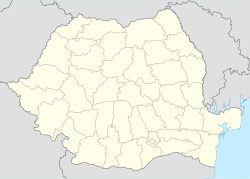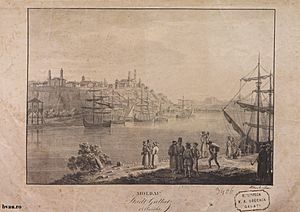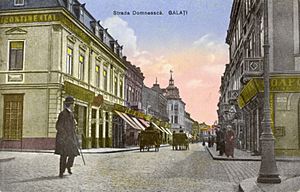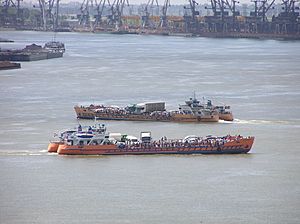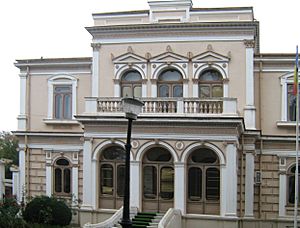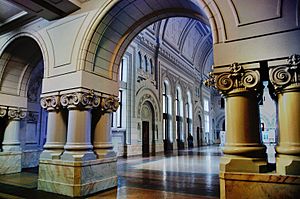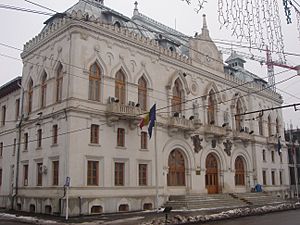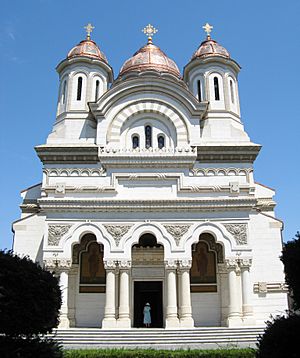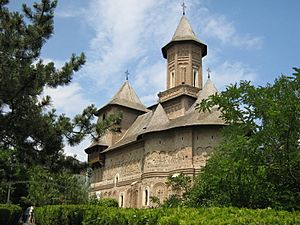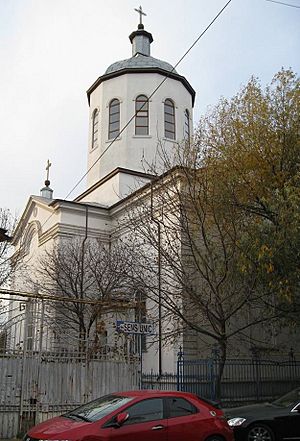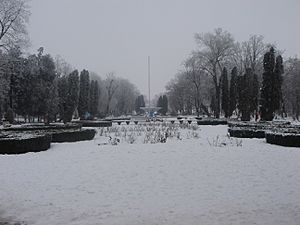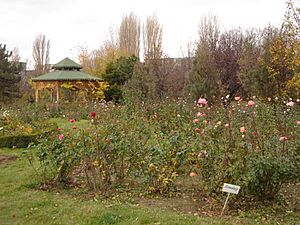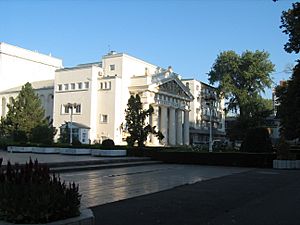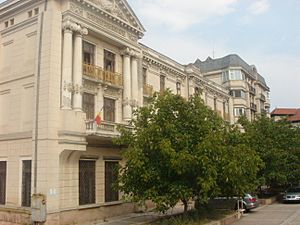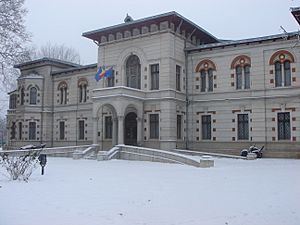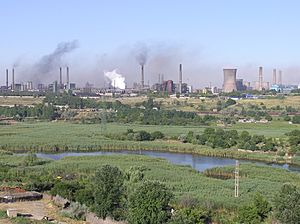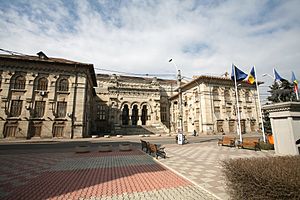Galați facts for kids
Quick facts for kids
Galați
|
|||
|---|---|---|---|
|
From left: Collections house, Greek Church, Administrative Palace of Galați, Moruzzi stairs, the Danube seen from Galați
|
|||
|
|||
| Nicknames:
The city of the linden trees
|
|||
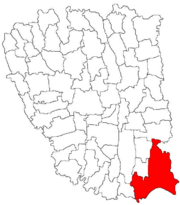
Location in Galați County
|
|||
| Country | |||
| County | Galați County | ||
| Status | County capital | ||
| Settled | Before 14th century | ||
| First official record | 1445 | ||
| Area | |||
| • County Seat | 246.4 km2 (95.1 sq mi) | ||
| Elevation | 55 m (180 ft) | ||
| Population
(2021 census)
|
|||
| • County Seat | 217,851 | ||
| • Density | 884.14/km2 (2,289.9/sq mi) | ||
| • Metro | 322,501 | ||
| Time zone | UTC+2 (EET) | ||
| • Summer (DST) | UTC+3 (EEST) | ||
| Postal Code |
800xxx
|
||
| Area code(s) | +40 x36 | ||
| Car Plates | GL | ||
Galați is a major city in eastern Romania. It is the capital of Galați County and an important port city on the Danube River. Galați is the sixth largest city along the Danube and the 8th most populated city in Romania, with about 217,851 people living there in 2021. The city is a busy economic center, known for its large port, naval shipyard, and Romania's biggest steel factory, Galați steel works.
Contents
- What's in a Name? The Story of Galați
- A Journey Through Time: Galați's History
- Exploring Galați: Geography
- Discovering Galați: Cityscape and Landmarks
- Cultural Life in Galați
- Galați's Economy
- People of Galați: Demographics
- Learning in Galați: Education
- Getting Around: Transportation
- Galați Around the World: International Connections
- Famous People from Galați
- Images for kids
- See also
What's in a Name? The Story of Galați
The name Galați likely comes from the Cuman word galat, which means "fortress". This word might have originally come from the Persian word kalat, also meaning "fortress". You can find the root galat in other nearby place names, like Gălățui Lake, which has a Cuman ending meaning "water".
Before the Mongol invasion, Galați was known as Malyi Halych (Little Halych). This was part of the Kingdom of Galicia–Volhynia. Other places with similar names include Galich, Russia and Galatia in Turkey.
Galați has many different names in other languages, such as Galátsi (Greek), Galatz (German), Galac (Hungarian), Gałacz (Polish), Kalas (Turkish), and Halac (Ukrainian).
A Journey Through Time: Galați's History
![]() Moldavia 1408–1859
Moldavia 1408–1859
![]() United Principalities of Moldavia and Wallachia 1859–1862
United Principalities of Moldavia and Wallachia 1859–1862
![]() Romanian United Principalities 1862–1866
Romanian United Principalities 1862–1866
![]() Romania 1866–1881
Romania 1866–1881
![]() Kingdom of Romania 1881–1947
Kingdom of Romania 1881–1947
![]() Romanian People's Republic 1947–1965
Romanian People's Republic 1947–1965
![]() Socialist Republic of Romania 1965–1989
Socialist Republic of Romania 1965–1989
![]() Romania 1989–present
Romania 1989–present
Ancient Times: Early Settlements
People have lived in the Galați area since the neolithic period, which was a very long time ago! Archeologists have found old tools and pottery here. Galați grew from an ancient settlement of the Dacian people, who lived here around 600-400 BCE. There was a special place where people could cross the Danube river.
Later, the Dacians fought wars against the Romans. The area became part of the Roman Empire. A strong Roman fortress was built at Barboși to protect the river crossing.
Medieval Period: A Growing Port
Galați has been continuously inhabited since the 600s. Old coins from the Byzantine Empire have been found here. At one point, the city was part of the Republic of Genoa's lands and was called "Caladda".
In 1445, Galați was first officially mentioned in a document. When the city of Chilia was taken over by the Ottomans in 1484, Galați became Moldova's only port. This made it very important for trade with Turkey and Poland. The Galați Jewish cemetery opened in 1590.
18th Century: Wars and Changes
The Ukrainian hero, Ivan Stepanovich Mazeppa, was buried in Galați in 1709. His tomb was made of brick.
In 1710, the city was attacked and damaged after the Battle of Stănilești. Later, in 1775, Russia opened a consulate in Galați. However, during the Russo-Turkish War of 1787–92, Russian armies burned Galați.
19th Century: Trade and Growth
After Russia took over half of the region in 1812, Galați became the only major port for the area. Because of conflicts in Europe, large warships were even built at the Galați port.
Despite wars, Galați grew because of trade, especially in grain. In 1805, France and England opened offices here. In 1837, Galați was made a free port, meaning goods could be traded without special taxes (though this ended in 1882). The U.S. also opened a consulate in 1858.
After the Romanian principalities united in 1859, Galați developed even more. The Mihai Eminescu municipal park opened in 1869. By 1870, many factories were starting up. The city's main railway station opened in 1872, and a river station opened in 1880. The V. A. Urechia library opened in 1889.
Early 20th Century to World War II
Before World War I, Galați continued to be a busy trading city with sixteen consulates. In 1907, there was social unrest among farmers, which led to the Romanian army getting involved.
Galați in World War I
Galați stayed under Romanian control during World War I. Romanian soldiers fought with Russian soldiers against the Central Powers. The city was bombed by Russian troops in January 1918.
Between the Wars
After the war, a high school for Jewish students opened in 1919. The first air race between Galați and Bucharest happened in 1926. By 1930, Galați had 100,000 residents, making it Romania's fifth largest city.
Galați in World War II
During World War II, Galați was bombed by Soviet and German air forces. Many historic buildings and much of the old town were destroyed, including the railway station. Soviet troops captured Galați in August 1944.
The Jewish Community
Before World War II, Galați had 22 synagogues. The Jewish community faced hardship during the war, but it was not destroyed in the Holocaust. Since the 1940s, many Jewish people have moved away.
Communist Period (1947–1989)
After World War II, Galați was rebuilt under communist rule. The city's population was about 80,000. In 1960, construction began on the Galați steel works, which opened in 1966. By then, the population had grown to 151,000.
Boating Accident
On September 11, 1989, a Bulgarian ship crashed into a cruise ship near Galați. Sadly, 151 people died in this accident.
Modern Galați
In 2004, Romania's first information technology park opened in Galați.
Floods
Galați has experienced severe floods. In July 2005, the Siret river reached very high levels, causing widespread flooding. In 2010, broken flood barriers also caused flooding in parts of the city.
Exploring Galați: Geography
Where is Galați?
Galați is in southeastern Romania. It is located on the left (west) bank of the Danube River, where the Siret River and the Prut River meet. It is about 80 kilometers (50 miles) from the Black Sea. The city of Brăila is only 15 kilometers (9 miles) south of Galați.
Galați is built on three different levels of land, like steps. The lowest part is called "Valley City," and the highest part is where the modern city stands.
The Danube River is like the "life-blood" of Galați. It is the second longest river in Europe, flowing for 2,850 kilometers (1,770 miles).
Galați's Weather
Galați has four clear seasons. Summers are very warm, with temperatures sometimes going above 35°C (95°F). Winters are cold and dry, with night temperatures sometimes dropping below -10°C (14°F). The most rain usually falls in June.
| Climate data for Galați, Romania (1991–2020 normals, extremes 1901-2020) | |||||||||||||
|---|---|---|---|---|---|---|---|---|---|---|---|---|---|
| Month | Jan | Feb | Mar | Apr | May | Jun | Jul | Aug | Sep | Oct | Nov | Dec | Year |
| Record high °C (°F) | 17.3 (63.1) |
22.4 (72.3) |
27.8 (82.0) |
31.8 (89.2) |
36.2 (97.2) |
37.8 (100.0) |
40.5 (104.9) |
40.4 (104.7) |
36.7 (98.1) |
33.5 (92.3) |
25.6 (78.1) |
20.0 (68.0) |
40.5 (104.9) |
| Mean maximum °C (°F) | 10.5 (50.9) |
15.1 (59.2) |
21.7 (71.1) |
25.5 (77.9) |
30.9 (87.6) |
34.0 (93.2) |
35.8 (96.4) |
35.9 (96.6) |
31.4 (88.5) |
26.1 (79.0) |
20.4 (68.7) |
12.3 (54.1) |
36.8 (98.2) |
| Mean daily maximum °C (°F) | 2.3 (36.1) |
5.2 (41.4) |
11.1 (52.0) |
17.7 (63.9) |
23.8 (74.8) |
27.8 (82.0) |
30.1 (86.2) |
30.0 (86.0) |
24.3 (75.7) |
17.2 (63.0) |
10.0 (50.0) |
3.8 (38.8) |
16.9 (62.5) |
| Daily mean °C (°F) | −1.1 (30.0) |
0.9 (33.6) |
5.7 (42.3) |
11.7 (53.1) |
17.6 (63.7) |
21.7 (71.1) |
23.9 (75.0) |
23.4 (74.1) |
17.9 (64.2) |
11.9 (53.4) |
6.0 (42.8) |
0.6 (33.1) |
11.7 (53.0) |
| Mean daily minimum °C (°F) | −3.8 (25.2) |
−2.3 (27.9) |
1.6 (34.9) |
6.9 (44.4) |
12.2 (54.0) |
16.3 (61.3) |
18.1 (64.6) |
17.7 (63.9) |
13.0 (55.4) |
7.9 (46.2) |
3.0 (37.4) |
−2.0 (28.4) |
7.4 (45.3) |
| Mean minimum °C (°F) | −13.5 (7.7) |
−11.6 (11.1) |
−5.1 (22.8) |
0.8 (33.4) |
6.0 (42.8) |
10.7 (51.3) |
13.1 (55.6) |
11.8 (53.2) |
6.7 (44.1) |
−0.1 (31.8) |
−4.7 (23.5) |
−10.7 (12.7) |
−15.7 (3.7) |
| Record low °C (°F) | −26.5 (−15.7) |
−28.6 (−19.5) |
−17.2 (1.0) |
−5.2 (22.6) |
−0.1 (31.8) |
3.8 (38.8) |
7.2 (45.0) |
2.4 (36.3) |
−5.7 (21.7) |
−15.6 (3.9) |
−21.5 (−6.7) |
−21.5 (−6.7) |
−28.6 (−19.5) |
| Average precipitation mm (inches) | 33.6 (1.32) |
25.9 (1.02) |
33.0 (1.30) |
40.1 (1.58) |
49.6 (1.95) |
62.2 (2.45) |
55.2 (2.17) |
34.0 (1.34) |
44.9 (1.77) |
51.3 (2.02) |
37.7 (1.48) |
41.3 (1.63) |
508.8 (20.03) |
| Average precipitation days (≥ 1.0 mm) | 4.9 | 5.3 | 5.0 | 6.2 | 7.4 | 7.1 | 5.5 | 4.2 | 4.7 | 4.0 | 4.7 | 5.6 | 64.6 |
| Average relative humidity (%) | 87 | 85 | 81 | 75 | 73 | 73 | 72 | 72 | 74 | 79 | 87 | 89 | 79 |
| Mean monthly sunshine hours | 81 | 113 | 161 | 203 | 255 | 274 | 299 | 282 | 219 | 156 | 86 | 73 | 2,202 |
| Source 1: NOAA | |||||||||||||
| Source 2: Romanian National Statistic Institute (extremes 1901–2000), Deutscher Wetterdienst (humidity 1973–1992) | |||||||||||||
| Climate data for Galați (1961–1990 normals) | |||||||||||||
|---|---|---|---|---|---|---|---|---|---|---|---|---|---|
| Month | Jan | Feb | Mar | Apr | May | Jun | Jul | Aug | Sep | Oct | Nov | Dec | Year |
| Mean daily maximum °C (°F) | 1.1 (34.0) |
3.0 (37.4) |
8.9 (48.0) |
16.6 (61.9) |
22.3 (72.1) |
25.9 (78.6) |
27.9 (82.2) |
27.5 (81.5) |
23.5 (74.3) |
16.9 (62.4) |
9.4 (48.9) |
3.4 (38.1) |
15.5 (60.0) |
| Daily mean °C (°F) | −2.5 (27.5) |
−0.6 (30.9) |
4.0 (39.2) |
10.8 (51.4) |
16.6 (61.9) |
20.2 (68.4) |
22.0 (71.6) |
21.4 (70.5) |
17.2 (63.0) |
11.1 (52.0) |
5.3 (41.5) |
0.2 (32.4) |
10.5 (50.9) |
| Mean daily minimum °C (°F) | −5.3 (22.5) |
−3.5 (25.7) |
0.2 (32.4) |
6.0 (42.8) |
11.2 (52.2) |
14.6 (58.3) |
16.2 (61.2) |
15.8 (60.4) |
12.0 (53.6) |
6.6 (43.9) |
2.1 (35.8) |
−2.4 (27.7) |
6.1 (43.0) |
| Average precipitation mm (inches) | 29.0 (1.14) |
32.0 (1.26) |
27.0 (1.06) |
38.0 (1.50) |
51.0 (2.01) |
68.0 (2.68) |
46.0 (1.81) |
46.0 (1.81) |
42.0 (1.65) |
27.0 (1.06) |
36.0 (1.42) |
35.0 (1.38) |
477 (18.78) |
| Average snowfall cm (inches) | 9.0 (3.5) |
7.9 (3.1) |
6.4 (2.5) |
0.0 (0.0) |
0.0 (0.0) |
0.0 (0.0) |
0.0 (0.0) |
0.0 (0.0) |
0.0 (0.0) |
0.0 (0.0) |
10.4 (4.1) |
7.0 (2.8) |
40.7 (16) |
| Average precipitation days (≥ 1.0 mm) | 5 | 6 | 5 | 6 | 7 | 8 | 6 | 5 | 4 | 4 | 5 | 5 | 66 |
| Average dew point °C (°F) | −4.3 (24.3) |
−3.2 (26.2) |
0.5 (32.9) |
5.4 (41.7) |
10.5 (50.9) |
14.1 (57.4) |
15.2 (59.4) |
14.6 (58.3) |
11.7 (53.1) |
6.9 (44.4) |
2.6 (36.7) |
−1.1 (30.0) |
6.1 (42.9) |
| Mean monthly sunshine hours | 77 | 87.2 | 142 | 193.7 | 255 | 286.9 | 306.3 | 296.9 | 233.7 | 187.1 | 86 | 64.7 | 2,216.5 |
| Source: NOAA NCEI | |||||||||||||
Military Importance
Galați is part of a key military area called the Focșani Gate. In the 19th century, the city was also part of a strong defensive line.
Discovering Galați: Cityscape and Landmarks
City Planning and Green Spaces
Galați is known for its many green spaces. In 2005, it was one of the top two cities in Romania for green space per person.
Interesting Places to Visit
Roman Camp at Tirighina-Barbosi
Archeologists have found an old Roman fort at Barbosi. They discovered Dacian pottery and Roman coins from the first century BCE to the first century CE. This shows that people lived and traded here a very long time ago.
Lambrinidi House
The Lambrinidi House is a historic building near the university. It was built by a Greek mill owner. Prince Charles once stayed here. Over the years, it has been a court, a high school, and even the city hall.
Robescu House
The Robescu House was built around 1896 by architect Ion Mincu. It has unique decorations inspired by the Brancoveanu style. Today, it is known as the "Children's Palace."
The Galați Palace of Navigation was designed by Petre Antonescu in the late 1800s. It is now the office for managing the Danube's waterways.
University Palace
This beautiful building was once the "Palace of Justice." It was built between 1911 and 1913. Now, it is the main building for the University of Galați.
Lupa Capitolina
This statue, meaning "Capitoline Wolf," was put up in 1995. It reminds people of the Roman influence in Galați.
Administrative Palace
Built in 1904-1905, this palace was also designed by Ion Mincu. It has white marble sculptures and a large clock that plays the "Danube Waves" waltz.
Places of Worship
Archdiocesan Cathedral of the Lower Danube
The building of this grand cathedral started in 1906 and finished in 1917. It has one large dome. Since 1989, the church has been restored. In 2006, the relics of St. Nectarios of Aegina were brought here.
Fortified Monastery of the Holy Virgin
This is the oldest building in Galați, consecrated in 1647. It was built with local materials and has special features for defense, like a bell tower with battlements to watch the Danube valley. It has been rebuilt and restored many times over the centuries.
Bulgarian Church
The Bulgarian Orthodox Church of Saint Pantaleon began construction in 1861 and was finished in 1887. It has a Neo-Byzantine design with Slavic influences. A Bulgarian school was also founded next to the church. The famous Bulgarian poet Hristo Botev lived here for a time.
Greek Church
The Greek Church was started in 1866 and dedicated in 1872. It has a cross shape with two bell towers. Inside, you can see large icons and beautiful stained glass windows.
St. Paraskeva Cathedral
This church is in the southern part of Galați. Its main construction is done, but the inside is still being finished.
Church Mavromol
Mavromol means "black rock" in Greek. This former monastery was built in 1669. It was damaged and rebuilt several times. The current building dates from 1858-1861. Monks from this church taught at Galați's first school in 1765.
The Church of St. Spyridon
Built in 1817, this church has four strong supports, three towers, and a dome. It holds valuable icons.
Synagogue of Galați
Today, there is only one synagogue left in Galați, located near the History Museum.
Masonic Temple
This temple was built in 1896 on the site of an older synagogue.
Schitul Vovidenia
This church was built in 1790. It is where Smaranda Cuza, the mother of Alexandru Ioan Cuza, is buried. The church was rebuilt after being burned in 1821.
Roman Catholic Church
Galați's Roman Catholic church was built in 1844 and made bigger in 1873. It has beautiful art, including a marble altar and statues. It was last renovated between 1985 and 1988.
Gardens, Parks, and Fun Places
Mihai Eminescu Municipal Park
This park was designed in 1869 to honor the poet Mihai Eminescu. Some of the trees are from his time. There's a small lake and a place for performances. You can also see a statue of Eminescu here.
Galați Public Gardens
This park is near the university and offers views of Lake Brates and the railway station.
C.F.R. (Romanian State Railways) Park
This park is located near the railway tunnel and public transport lines.
Botanical Garden
The Botanical Garden is on the bank of the Danube. It has a museum of natural history, collections of tropical plants, over 200 types of roses, and a Japanese garden.
Garboavele Zoo and Reserve
Located outside the city, the Garboavele Forest Zoo has many exotic animals. You can also go horseback riding here. The zoo works to protect rare animals and teach people about conservation.
Hunters Lake
Hunters Lake is in the far north-east of Galați. It has a natural lake, a forest, and parkland for recreation.
Danube Leisure Complex
This park is on the road to Brăila. It has swimming pools, camping areas, and restaurants.
Waterfront
The waterfront is a green area perfect for walking, sports, and enjoying the view. Some boats on the Danube have been turned into restaurants. You can also see old iron relics and a statue of Nicolae Balcescu.
Danube Waves Beach
This beach is in southwest Galați. It's popular in summer with large pools, smaller pools for kids with slides, and restaurants.
Brateș Beach
This is a private beach with clean sand on the left bank of Lake Brates.
City Neighborhoods
- Port
- Centru
- Gară
- Parc Rizer
- Campus Universitar
- Mazepa 1
- Mazepa 2
- Țiglina 1
- Țiglina 2
- Țiglina 3 (Micro 16)
- Țiglina 4 (Micro 17 and Micro 18)
- Bariera Traian
- Traian Nord
- Barboși
- I.C. Frimu
- Siderurgiștilor Est
- Siderurgiștilor Vest
- Danube
- Micro 13a
- Micro 13b
- Micro 14
- Micro 19
- Micro 20
- Micro 21
Cultural Life in Galați
Theatres
Fani Tardini Drama Theatre
This theatre opened in 1955 and is named after actress Fani Tardini. It hosts a yearly comedy festival called "Festingal."
Nae Leonard National Theatre of Opera and Operetta
Named after Nicolae Leonard, "the prince of operetta," this theatre opened in 1956.
Gulliver Theatre
The Gulliver Theatre opened in 1952 and specializes in children's theatre, including puppetry.
Museums
Natural Sciences Museum Complex
This museum is located in the Botanical Gardens. It has a planetarium, an aquarium with local and exotic fish, and various plant collections.
Galați History Museum
Opened in 1939, this museum is in the former home of Cuza, Galați's chief magistrate. It displays many historical items, including finds from the Roman fort at Tirighina-Bărboși.
Alexandru Ioan Cuza Memorial House
This museum is in Cuza's old home and shows exhibits about his life.
Visual Arts Museum
When it opened in 1967, this was Romania's first museum of contemporary art. It has art from the 19th and 20th centuries.
Galați Village Museum
Located at the entrance to the Garboavele forest, this museum shows traditional Romanian village life with small village buildings.
House of Collections
This museum is near the Alexandru Ioan Cuza Memorial House. It has collections of stamps (philately) and coins (numismatics).
Rivalry with Brăila
Galați has a long-standing friendly rivalry with its neighboring city, Brăila. This competition is so well-known that researchers have even written a book about it!
Galați's Economy
Galați is home to Romania's largest iron and steel plant, the Galați steel works, now owned by Liberty House Group. It's often still called "Sidex," its old name.
The city also has Romania's largest shipyard. Its location on the Danube, with easy access to the Black Sea, and its closeness to the steel works make it a great place for shipbuilding.
Galați is also a border checkpoint for people traveling to and from Moldova.
People of Galați: Demographics
| Historical population | ||
|---|---|---|
| Year | Pop. | ±% |
| 1859 | 26,050 | — |
| 1900 | 62,678 | +140.6% |
| 1912 | 71,641 | +14.3% |
| 1930 | 100,611 | +40.4% |
| 1941 | 95,545 | −5.0% |
| 1948 | 80,411 | −15.8% |
| 1956 | 95,646 | +18.9% |
| 1966 | 151,412 | +58.3% |
| 1977 | 238,292 | +57.4% |
| 1992 | 326,141 | +36.9% |
| 2002 | 298,861 | −8.4% |
| 2011 | 249,432 | −16.5% |
| 2021 | 217,851 | −12.7% |
| Source: Census data, 1930–1948. | ||
City Population
In 2021, about 217,851 people lived within the city limits of Galați.
Ethnic Groups
Most people in Galați are Romanians (98.54%). Other groups include Roma (0.78%), Lipovans (0.07%), Greeks (0.07%), and Hungarians (0.09%).
Learning in Galați: Education
Galați has schools and universities for all ages. School Nr. 24 (Holy Archangels Michael and Gabriel) is the oldest school in the county, founded in 1832.
The University of Galați, founded in 1974, has 11 faculties. It has unique departments in Romania, like The Faculty of Naval Architecture and Department of Food Science and Engineering.
"Danubius University" is a private university with programs in law, economics, and social studies.
Galați also has several special research institutes. Four of them are unique in Romania, focusing on shipbuilding, metal products, fish research, and wine research.
Libraries
V. A. Urechia Library
The V. A. Urechia Library was founded in 1889. In 1991, it moved to a new building. It has a collection of local history books and rare books.
Getting Around: Transportation
Public Transport
You can get around Galați using trams, trolleybuses, and buses. These are all run by Transurb, a city agency.
Rail Travel
The Galați railway station has direct train services to major Romanian cities like Bucharest, Cluj-Napoca, Brașov, and Iași. In the summer, you can also take a train to Constanța.
Galați Around the World: International Connections
Galați has many twin towns and sister cities around the world:
|
|
Famous People from Galați
Images for kids
See also
 In Spanish: Galați para niños
In Spanish: Galați para niños









